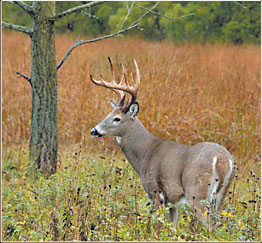Author: Hunter Brant, President of Oakwood Realty Group
Date: September 29th, 2013
As the Quality Deer Management philosophy becomes further anchored as the dominant mindset among whitetail hunters, achieving greater numbers of mature bucks is not the hurdle it once was. Instead, there’s another hurdle: Killing them. Answering that challenge is the “sanctuary,” a landscape feature that has recently become a familiar part of conversations about hunting tactics, property set-up, and small-acreage management.
There are two kinds of sanctuaries used by mature bucks. The most common is the kind hunters create unknowingly. They are the places we don’t like to go because they are inconvenient, difficult to get into, or because we perceive some other place – like a food plot or a stand where we had success in the past – is a better place to hunt. Bucks use these sanctuaries to avoid us, but because we don’t know they do, we can’t capitalize.
The second kind of sanctuary is one hunters actively designate. Bucks use these sanctuaries to avoid us, but because we know they do, we can capitalize. We can use designated sanctuaries to shelter immature bucks we don’t want to harvest but someone else might; to encourage these bucks to spend more time on our hunting land throughout their lives; to encourage mature bucks to use our land when regional hunting pressure intensifies; and to allow us to predict the movements of mature bucks so we can kill them.
The above was an excerpt from an article written by Lindsay Thomas Jr, author at QDMA. You can read more of this article at: http://www.qdma.com/articles/sanctuaries-attract-protect-hold-hunt
I thought I would pass this article along as it contains some management insights that I think are very good. The following are my thoughts and applications regarding sanctuaries and harvesting mature bucks in the southeast, particularly Florida and Georgia.
On a recent July weekend in North Florida I was experiencing extreme weight loss trying to move some bow stands. Unfortunately the hunting season and cool weather do not coincide here in Florida. The reason for me to be out of the office in this heat was directly related to the article above. SUMMER is time to be moving your bow stands to some of these protected and un-traveled areas BEFORE the season is weeks away. The author didn’t get into that directly but early summer is the time to move your bow stands and look for new “sanctuary” type areas. These areas are most easily found by drawing out your existing stands and heaviest activity areas on an aerial and then seeing where the areas are that never get human activity. This exercise will give you a head start when you get to the woods to locate some productive bow stands for the fall!
When looking for stand locations too may hunters concentrate on all too obvious forage sites for hunting places. This strategy results in two things we can learn from.
- When the majority of the hunting pressure occurs on or around food plots there are going to be some unintended sanctuaries created. If you can recognize those areas and sneak in briefly during the summer and hang a bow stand, then combine that site with some scouting intelligence you can increase your chances dramatically. Think of it this way, once you identify the “where”, use your trail camera to identify the “when” and that information should provide you with the “X” to help you harvest a mature buck!
- How to hunt food plots: When food plots are over-hunted hunting success goes down. Conversely when food plots are hunted sparingly and does are not harvested over food plots the opportunity to see a mature buck on that site during the daylight goes way up. Replacing hunting pressure with trail cameras allows you to observe deer movements without disturbing the area. Combine this scouting intelligence with the rut and a site that hasn’t been hunted and your chances go up exponentially! Don’t hunt those sites until the timing and conditions are right!
Good luck this fall!
By: Hunter Brant
President of B&W Habitat
B&W is a wildlife and land management consulting company. Hunter has a degree in Forestry and Finance from the University of Florida and has over 13 years experience in managing land in southeast to maximize its potential.

